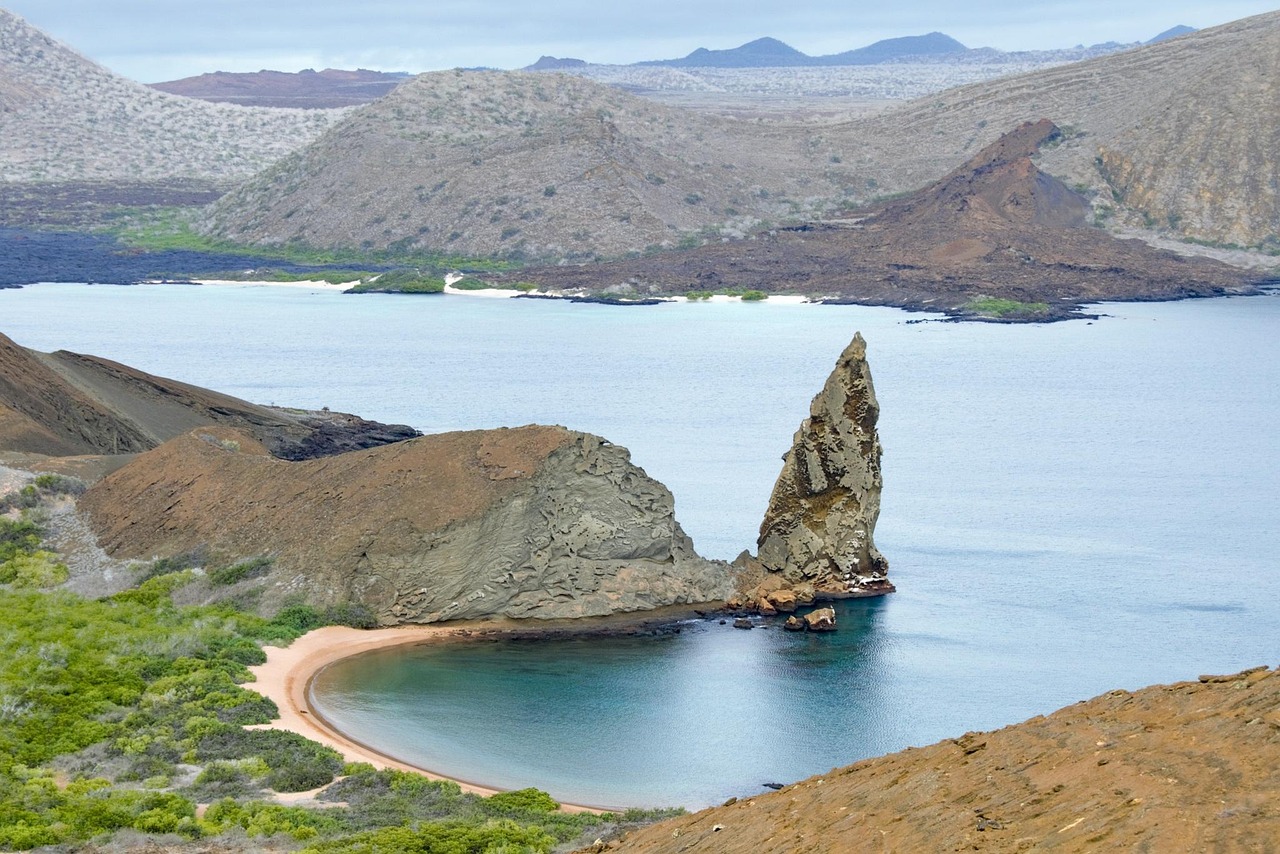Planning a solo trip can be tricky. The Galapagos Islands offer a unique adventure for travelers. This guide will show you how to enjoy wildlife watching as a solo visitor here. Ready to explore?
Key Takeaways
- The Galapagos Islands are safe for solo travelers who love wildlife. There are low crime rates and friendly locals.
- You can see unique animals like marine iguanas, sea lions, blue-footed boobies, and frigatebirds.
- Different ways to explore the islands include joining wildlife cruises or doing it yourself with land-based trips.
- Best time to visit is between December to May for breeding season or June to November for better snorkeling conditions due to cooler sea temperatures.
- It’s important to respect the environment and support local communities by following park rules and choosing sustainable tours.
Why the Galapagos Islands Are Perfect for Solo Travelers

The Galapagos Islands are safe and traveler-friendly, making it ideal for solo adventurers. You’ll encounter unique wildlife experiences that provide a sense of wonder and excitement.
Safe and traveler-friendly destination
Safety is a big plus for solo travelers heading to the Galapagos Islands. Here, crime rates are low. This means you can explore and enjoy the wonders of these islands without much worry.
The locals are friendly too. They welcome visitors with open arms.
Traveling alone here does not mean feeling lonely. You will meet other travelers who share your love for nature and adventure. Guides and tour operators know the place well. They make sure you have a safe, enjoyable experience while watching wildlife or snorkeling in clear blue waters.
Unique wildlife experiences
The Galapagos Islands offer solo travelers a chance to see animals found nowhere else. Here, you can watch marine iguanas swim and sunbathe beside you. These creatures are the only sea-going lizards in the world, making them a must-see for wildlife lovers.
Walking along sandy beaches might also surprise you with sea lions playing or relaxing nearby. They’re friendly and often approach humans out of curiosity.
Bird watchers have plenty to enjoy too. The islands are home to the famous blue-footed boobies, known for their bright blue feet and unique mating dance. You’ll find these birds showing off their feet in hopes of attracting a partner—a sight that’s both amusing and unforgettable.
Then there are the magnificent frigatebirds, easily spotted by their large red throat pouches during mating season, soaring high above the islands. Each island offers its own set of wonders ready to be discovered on your solo adventure.
Top Wildlife to Watch in the Galapagos
Discover the diverse Galapagos finches and their importance to Charles Darwin’s theory of evolution. Observe the mesmerizing marine iguanas and playful sea lions, along with the captivating blue-footed boobies and frigatebirds during your island exploration.
Galapagos finches and their significance
Galapagos finches are famous birds that gained attention thanks to Charles Darwin’s research. These little birds play a big role in understanding evolution. Each island has its own types of finches, showing how animals adapt to different places.
For example, some finches have strong beaks to crack nuts, while others have long ones to get nectar from flowers.
Seeing these finches is like looking at nature’s science class live. They show us how life can change over time based on the environment. Next up, let’s dive into other unique creatures like marine iguanas and sea lions you’ll meet on your trip.
Marine iguanas and sea lions
Marine iguanas and sea lions are among the captivating wildlife experiences in the Galapagos Islands. As a solo traveler, you can witness marine iguanas basking in the sun on volcanic rocks while sea lions playfully interact along the shores.
The Galapagos is home to nearly 20,000 marine iguanas and around 50,000 sea lions.
With their unique appearance and behavior, these creatures offer exceptional opportunities for photography and wildlife observation. Snorkeling alongside marine iguanas allows you to witness their remarkable ability to swim gracefully underwater, making it an unforgettable experience during your solo adventure.
Additionally, observing playful interactions between sea lion colonies provides an incredible insight into their social behaviors in their natural habitat.
Blue-footed boobies and frigatebirds
Blue-footed boobies and frigatebirds are must-see attractions in the Galapagos Islands. They showcase unique behaviors and vibrant displays that captivate nature enthusiasts, bird watchers, and wildlife photographers alike.
These iconic birds can be spotted throughout the archipelago, offering solo travelers abundant opportunities for up-close encounters. With their distinctive blue feet and remarkable aerial acrobatics, blue-footed boobies steal the show during mating rituals.
Frigatebirds, on the other hand, with their impressive wingspan and striking red throat pouches, demonstrate unparalleled grace as they soar above the islands’ volcanic landscapes.
Visitors to the Galapagos Islands have a chance to witness these avian wonders in their natural habitat—whether on guided wildlife excursions or while exploring at their own pace.
The Galapagos National Park regulations ensure minimal disturbance to these magnificent creatures while providing an enriching experience for travelers seeking unforgettable encounters with some of the world’s most fascinating bird species.
Best Ways to Explore the Islands as a Solo Traveler
Discover the Galapagos Islands solo by joining wildlife cruises or embarking on DIY land-based trips. Immerse yourself in the unique wildlife and breathtaking landscapes at your own pace.
Joining Galapagos wildlife cruises
Explore the wildlife by joining Galapagos wildlife cruises. Get up close to marine iguanas, sea lions, and blue-footed boobies on guided excursions. Take advantage of photography opportunities and expert insights while cruising between islands in ultimate comfort.
Joining Galapagos wildlife cruises is a great way to witness the unique biodiversity of the islands. Cruise operators offer various itineraries focused on wildlife exploration, ensuring you don’t miss out on renowned spots like the Charles Darwin Research Station or the tortoise breeding center.
Immerse yourself in this adventure with fellow solo travelers and create unforgettable memories aboard these specialized tours.
DIY land-based trips and their benefits
Engage in snorkeling, birdwatching opportunities. Galapagos National Park fees apply but are lower for land-based visits compared to cruises. Enjoy volcanic landscapes up close without feeling rushed by tour schedules or group activities.
Types of Tours for Solo Travelers
Explore the options for solo travelers, from luxurious cruises to budget-friendly choices. Choose from adventure-focused tours or independent land-based trips for a personalized experience.
Each tour offers unique opportunities to immerse in Galapagos’ wildlife and breathtaking landscapes.
Luxury cruises for ultimate comfort
Pamper yourself on luxury Galapagos wildlife cruises, ensuring a comfortable and indulgent experience. These high-end cruises provide lavish amenities, spacious cabins with panoramic views, gourmet dining options, and top-notch service.
Onboard naturalist guides offer insightful wildlife commentary during excursions to witness the iconic species of the islands.
Treat yourself to luxury aboard these cruises as you explore the Galapagos Islands in style. Enjoy exclusive access to remote sites and personalized attention from attentive staff.
Immerse yourself in comfort after thrilling encounters with abundant marine life while snorkeling or witnessing endemic birds in their natural habitat.
Budget-friendly options for independent travelers
After exploring luxury cruise options, independent travelers on a budget can still enjoy the Galapagos Islands. Opt for land-based trips that allow you to stay in local accommodations and take day tours, offering significant cost savings without compromising the wildlife experience.
Additionally, consider booking smaller boats or yachts for day trips instead of multi-day cruises to reduce expenses while still being able to explore the stunning marine life and landscapes of the Galapagos Islands.
These budget-friendly choices provide an authentic experience while allowing solo travelers to immerse themselves in the remarkable wildlife and nature that make the Galapagos Islands so special without breaking the bank.
Embracing these alternatives ensures that independent travelers can enjoy all that this unique destination has to offer while staying within their budget constraints.
Multisport and adventure-focused tours
The Galapagos Islands offer a range of multisport and adventure-focused tours for solo travelers. These tours allow you to actively explore the islands, engaging in activities like snorkeling among vibrant marine life, hiking through volcanic landscapes, and kayaking around isolated coves.
With these tours, you can immerse yourself in the unique environment Charles Darwin found so inspiring. You’ll have the chance to see diverse wildlife up close and gain a deeper understanding of this extraordinary ecosystem while enjoying thrilling outdoor adventures that make your solo trip unforgettable.
These tours are designed for those looking to experience the natural wonders of the Galapagos Islands while participating in exciting activities such as exploring pristine beaches, venturing into remote areas accessible only by foot or sea, and encountering endemic species thriving in their natural habitats.
By joining these adventurous excursions specifically tailored for solo travelers, you’ll create lasting memories of your wildlife watching experience while reveling in the breathtaking beauty and unparalleled biodiversity that awaits exploration throughout this remarkable archipelago.
When to Visit the Galapagos Islands
The best months for wildlife activity in the Galapagos are from December to May, offering a chance to witness breeding and nesting seasons. However, if you prefer warmer weather and better snorkeling conditions, consider visiting between June and November during the dry season.
For seasonal highlights and weather considerations tailored for solo travelers, click here to read more.
Best months for wildlife activity
The best months for wildlife activity in the Galapagos Islands are from June to December. During these months, you can see marine iguanas nesting and breeding on the shores. It’s also a great time to witness the famous albatross courtship rituals and nesting, especially on Española Island.
The nutrient-rich waters brought by the Humboldt Current attract an abundance of marine life, making it an excellent time for snorkeling with sea turtles, playful sea lions, and colorful fish.
These months offer unique opportunities to observe nature at its most active state while visiting the Galapagos Islands.
Seasonal highlights and weather considerations
The Galapagos Islands have two main seasons: the warm and wet season from December to May, and the dry and cool season from June to November. The warm season brings higher temperatures and occasional rain showers, while the dry season features cooler waters, clearer skies, and stronger winds.
Between June to November, sea temperatures drop due to the cold Humboldt Current, making it a great time for snorkeling with marine wildlife species such as sea turtles.
During December to May, rainfall nourishes plant life on the islands, turning landscapes lush green. This is also when many seabirds are nesting and several plant species are in bloom.
However, seas can be a bit rougher during this time. It’s important to consider these seasonal variations when planning your solo trip – you may want to prioritize specific wildlife encounters or weather conditions based on your interests.
Tips for Planning Your Solo Trip
Plan your itinerary carefully to maximize wildlife watching opportunities, pack smart and light for easy island hopping, and research transportation options beforehand—the key to a successful solo trip.
Read more about planning an unforgettable adventure in the Galapagos Islands!
Choosing the right itinerary
When considering the right itinerary for your solo trip to the Galapagos Islands, think about what wildlife you want to see and how you prefer to get around. Wildlife cruises are great for exploring different islands while staying aboard a ship.
If you enjoy more flexibility, consider land-based trips where you can stay in one place longer and have more interaction with local communities. There are also options for luxury cruises or budget-friendly independent travel experiences based on your preferences and budget.
Keep wildlife excursions, snorkeling opportunities, and bird-watching in mind when deciding which itinerary suits your interests best.
Packing essentials for wildlife watching
When preparing for wildlife watching in the Galapagos Islands, it’s crucial to pack some essential items. First, bring a good pair of binoculars to get a closer look at the unique bird and animal species on the islands.
For comfortable exploration, sturdy and waterproof hiking boots are essential due to the volcanic landscapes and varied terrain. Don’t forget lightweight, breathable clothing suitable for warm weather as well as protection from occasional rain or strong sun exposure.
Additionally, carry a reusable water bottle to stay hydrated during your wildlife excursions.
To capture memorable moments of the diverse wildlife, consider bringing a quality camera with zoom capabilities and spare memory cards or film. As you venture between islands and engage in snorkeling activities, pack reef-safe sunscreen that won’t harm marine life.
Lastly, include insect repellent in your packing list for enhanced comfort during outdoor experiences on the islands.
Navigating transportation between islands
Getting around the Galapagos Islands as a solo traveler is mainly done by boat. There are inter-island ferries or small cruise ships to move between islands. Many of these boats offer day trips or multi-day excursions, allowing you to explore various islands while enjoying guided wildlife tours and snorkeling opportunities.
Another option is to fly between the islands on small planes operated by local airlines, providing a quicker but costlier alternative for island hopping.
Some larger inhabited islands have taxis and public transportation options like buses and water taxis to take you around locally. But keep in mind that some areas may be best explored on foot, so it’s good to pack comfortable walking shoes for exploring the different landscapes each island offers, from volcanic craters to pristine beaches.
Responsible Travel in the Galapagos
Ensure the protection of natural habitats and wildlife. Contribute to the local economy by supporting businesses that prioritize sustainability.
Preserving the environment
Preserving the environment in the Galapagos Islands is crucial. The wildlife and natural habitats here are delicate and need protection. The Galapagos National Park, established in 1959, safeguards around 97% of the land area and sets strict guidelines for visitors to minimize their impact on this unique ecosystem.
For instance, tourists must stay on marked paths, avoid littering, and not disturb animals or plants. Additionally, snorkeling and diving are regulated to prevent damage to marine life.
By following these rules, visitors contribute to preserving the islands’ ecological balance and ensuring future generations can also enjoy its wonders.
Moreover, responsible tourism plays a key role in safeguarding the environment in Galapagos. Supporting local communities by purchasing locally-made souvenirs or choosing eco-friendly accommodations helps sustain the islands’ economy while minimizing negative impacts on nature.
Choosing tour operators committed to sustainability practices further supports conservation efforts, making sure that wildlife watching adventures do not harm the very creatures they aim to admire.
Supporting local communities
Preserving the environment in the Galapagos isn’t just about protecting wildlife; it also involves supporting local communities. Many businesses on the islands are dedicated to sustainable tourism and helping locals thrive.
When you join a tour or book accommodations, opt for providers that prioritize hiring local guides and staff, contributing to community development. Additionally, consider purchasing souvenirs directly from artisans or cooperatives, as this empowers local craftsmen and women while ensuring your money stays within the community.
By choosing responsible tour operators and supporting local businesses, solo travelers can make a positive impact during their visit to the Galapagos Islands while creating opportunities for economic growth within these unique island communities.
Conclusion
The Galapagos Islands offer an incredible adventure for solo travelers. From unique wildlife encounters to safe and traveler-friendly environments, it’s a perfect destination. Whether you’re snorkeling with marine iguanas or exploring volcanic landscapes, the Galapagos promises unforgettable experiences.
As you plan your solo trip, remember to be respectful of the environment and support local communities. Get ready to embark on a once-in-a-lifetime wildlife watching journey in the remarkable Galapagos Islands!
FAQs
1. What can I see while wildlife watching in the Galapagos Islands?
When you go wildlife watching in the Galapagos Islands, you can see unique animals like giant tortoises, blue-footed boobies, and marine iguanas. The islands are home to many species that can’t be found anywhere else.
2. Is a solo trip to the Galapagos safe?
Yes, a solo trip to the Galapagos can be safe if you plan well. Many travelers explore on their own and find friendly locals who help them along the way. Just keep your belongings close and stay aware of your surroundings.
3. How do I get around in the Galapagos Islands?
You can get around by taking boats between islands or using local transportation options like taxis or buses on each island. Some people also rent bikes for exploring at their own pace.
4. When is the best time to visit for wildlife watching?
The best time for wildlife watching depends on what you want to see! Generally, from June to November is great for spotting marine life, while December through May offers warmer weather and more bird activity during nesting season.







Leave a Reply